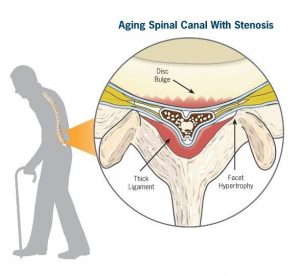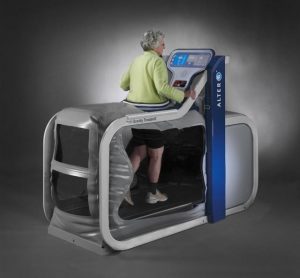Degenerative Lumbar Spinal Stenosis – Patient Handout
What is Degenerative Lumbar Spinal Stenosis?
Degenerative Lumbar Spinal Stenosis (DLSS) is a condition where the size of your spinal canal is decreased through the natural process of ageing. In some individuals, for reasons unknown, the ageing process will lead to a reduction of the space in their backs where the spinal cord and nerves are located. As a consequence, patients suffering from lumbar stenosis may experience some back pain and leg symptoms (figure 1).
DLSS is where the size of your spinal canal is decreased through the natural process of ageing. Share on X
Figure 1
What are the common symptoms and how do I know if I have DLSS?
Common symptoms are a dull ache or heaviness sensation to both legs which can also manifest in one leg only. Those above 50 years of age are more susceptible to develop spinal stenosis but there are no differences in incidence by gender. People with DLSS normally feel relief whilst sitting, crook lying or bending forward. At the same time, lying flat, standing, walking or high impact activities will increase symptoms, particularly bending backwards. That description is quite the opposite from people suffering other types of back pain (figure 2).

Figure 2
Common diagnosis is given via thorough interview with a trained health professional and supplemented by imaging scans, such as X-ray or MRI. It is paramount to say that imaging scans suggesting spinal stenosis in the absence of other clinical signs do not constitute a diagnosis of DLSS. X-ray and MRI spinal canal narrowing are common findings in asymptomatic individuals.
I have been diagnosed with DLSS, what are my treatment options and can I exercise?
Both, surgical and conservative approaches are recommended on a case to case basis. Scientific evidence still debates the topic but there is some consensus about management:
- Researches and expert clinicians mostly agree that for mild to moderate cases, conservative treatment comprising of active physiotherapy strategies such as exercises and cardiovascular training are beneficial in improving functional capacity and pain.
- Severe cases seem to respond better to decompressive surgery. However, in the long run those benefits tend to wear off and outcomes are similar to conservative management.
- Other forms of conservative management, such as steroid injections and the use of back braces do not seem to help.
- A combination of exercises, manual therapy (massage, spinal manipulations etc.) and cardiovascular training may promote slightly superior self-reported relief than exercises alone.
So if you have received a diagnosis of DLSS, exercise may be an appropriate strategy for you to get some relief and improve fitness (figure 3). Unfortunately, there is no “fixing” for DLSS. As a chronic condition, strategies focusing on symptom management and function are considered the best options. Be guided by your treating health practitioner on what is best for you. Below you will also find a “self-check tool” to help you get started.
Exercise may be an appropriate strategy for you to get some relief. #performbetter @pogophysio Share on X

Figure 3
Be proactive regarding your health and do not jump on “my scans show degeneration” bandwagon too quick. It is paramount to stress imaging scans are great to support and clarify a clinical diagnosis, however, as a stand-alone they do not consist the diagnosis itself.
Also worth mentioning this article does not cover other types of lumbar stenosis such as those caused by malignancies, disc extrusion and fractures and others.
Quick Self-Check Tool

Happy exercising!
Bruno Rebello (APAM)
Physiotherapist

References
- Szpalski M, Gunzburg R. Lumbar spinal stenosis in the elderly: an overview. European spine journal : official publication of the European Spine Society, the European Spinal Deformity Society, and the European Section of the Cervical Spine Research Society. 2003;12 Suppl 2:S170-5.
- Genevay S, Atlas SJ. Lumbar spinal stenosis. Best practice & research Clinical rheumatology. 2010;24(2):253-65.
- Suri P, Rainville J, Kalichman L, Katz JN. Does this older adult with lower extremity pain have the clinical syndrome of lumbar spinal stenosis? Jama. 2010;304(23):2628-36.
- Benoist M. Natural history of the aging spine. European spine journal : official publication of the European Spine Society, the European Spinal Deformity Society, and the European Section of the Cervical Spine Research Society. 2003;12 Suppl 2:S86-9.
- Whitman JM, Flynn TW, Childs JD, Wainner RS, Gill HE, Ryder MG, et al. A comparison between two physical therapy treatment programs for patients with lumbar spinal stenosis: a randomized clinical trial. Spine. 2006;31(22):2541-9.
- Backstrom KM, Whitman JM, Flynn TW. Lumbar spinal stenosis-diagnosis and management of the aging spine. Manual therapy. 2011;16(4):308-17.
- Nord T, Kornerup U, Gronlund P, Reuterwall C. [Exercise reduced the need for operation in lumbar spinal stenosis. Circulatory load in the form of cycling gave good effect]. Lakartidningen. 2015;112.
- Zaina F, Tomkins-Lane C, Carragee E, Negrini S. Surgical Versus Nonsurgical Treatment for Lumbar Spinal Stenosis. Spine. 2016;41(14):E857-68.









